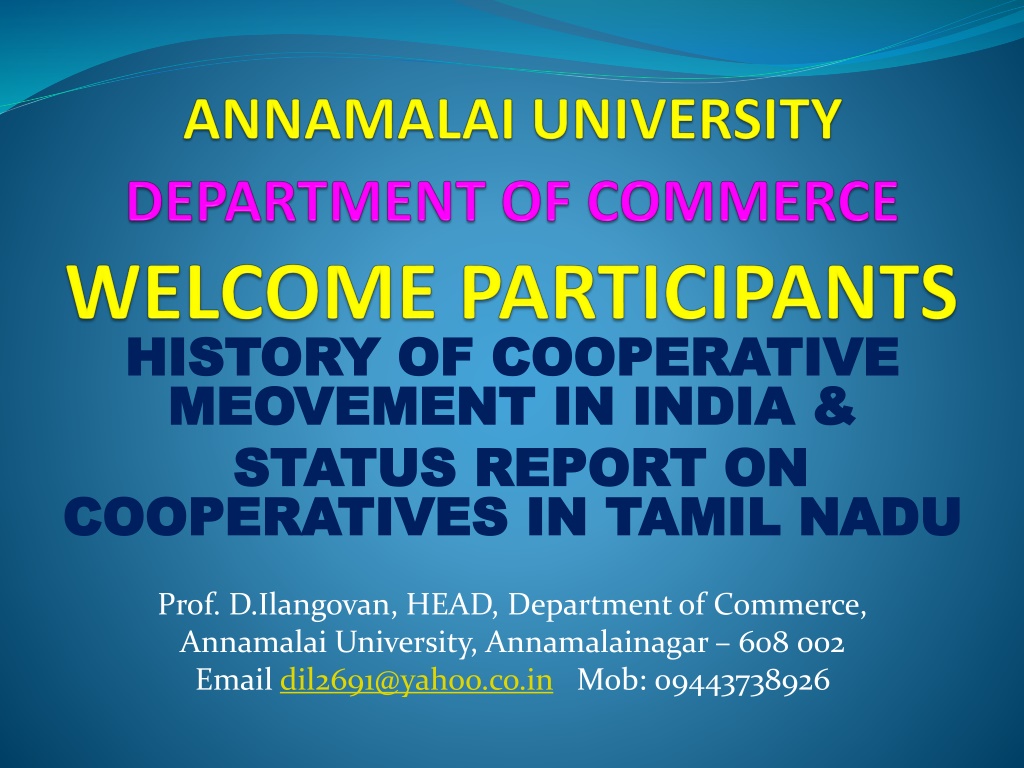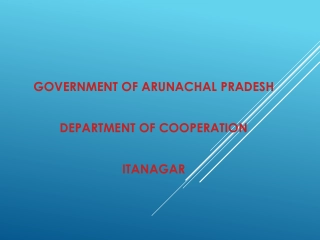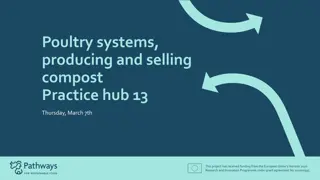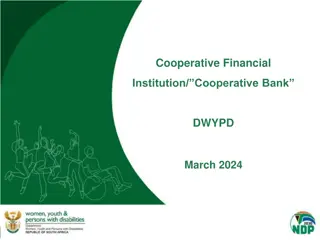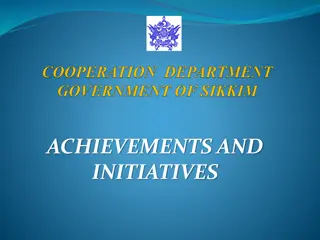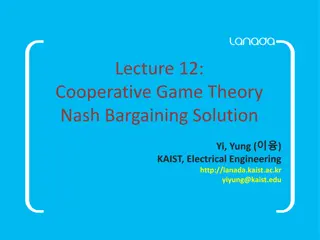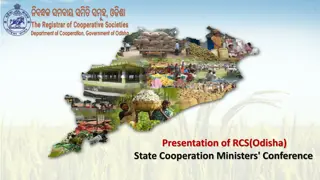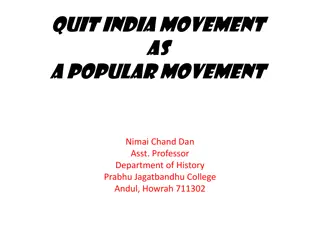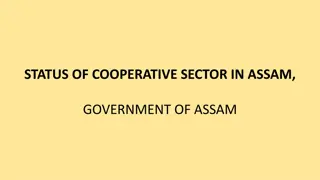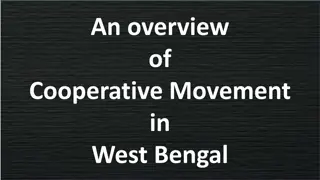History and Principles of Cooperative Movement in India
Explore the history and principles of cooperative movement in India, including open membership, democratic control, and member participation. Learn about the values and definition of cooperatives, as well as the important role of members in a cooperative society. Delve into the key principles that guide cooperative practices and understand the significance of cooperation among cooperatives. Discover the responsibilities of cooperative members and how they can contribute to the success of the cooperative model.
Download Presentation

Please find below an Image/Link to download the presentation.
The content on the website is provided AS IS for your information and personal use only. It may not be sold, licensed, or shared on other websites without obtaining consent from the author. Download presentation by click this link. If you encounter any issues during the download, it is possible that the publisher has removed the file from their server.
E N D
Presentation Transcript
HISTORY OF COOPERATIVE HISTORY OF COOPERATIVE MEOVEMENT IN INDIA & MEOVEMENT IN INDIA & STATUS REPORT ON STATUS REPORT ON COOPERATIVES IN TAMIL NADU COOPERATIVES IN TAMIL NADU Prof. D.Ilangovan, HEAD, Department of Commerce, Annamalai University, Annamalainagar 608 002 Email dil2691@yahoo.co.in Mob: 09443738926
Principles of Cooperation This list became one of the first sets of cooperative principles, characteristics that distinguish cooperatives from non-cooperative business entities. Open membership One member, one vote Cash trading Membership education Political and religious neutrality No unusual risk assumption Limitation on the number of shares owned Limited interest on stock Goods sold at regular retail prices Net margins distributed according to patronage Prof.D.Ilangovan, HD Commerce AU 18-04-2020 2
The ICA Principles,Values & Definition Definition: A cooperative is an autonomous association of persons united voluntarily to meet their common economic, social, and cultural needs and aspirations through a jointly-owned and democratically controlled enterprise. Values: Cooperatives are based on the values of self-help, self-responsibility, democracy, equality, equity, and solidarity. In the tradition of their founders, cooperative members believe in the ethical values of honesty, openness, social responsibility, and caring for others. Principles: The cooperative principles are guidelines by which cooperatives put their values into practice. 1st Principle: Voluntary and Open Membership 2nd Principle: Democratic member Control 3rd Principle: Member Economic Participation 4th Principle: Autonomy and Independence 5th Principle: Education, Training and Information 6th Principle: Cooperation among Cooperatives 7th Principle: Concern for Community Prof.D.Ilangovan, HD Commerce AU 18-04-2020 3
Role of Members in a Coop. Society 1. Patronize the cooperative. Members must make a conscious decision to be committed to the cooperative, even when short-term prices or services may be better elsewhere. 2. Be informed about the cooperative. To carry out their other duties, members must know what the cooperative is about; what it can do for them; its purpose, objectives, policies; and the issues it faces. They can obtain information through annual meetings, reports and newsletters, and from talking to the manager, staff, directors and other members. 3. Be conscientious when selecting and evaluating directors. They select from among their peers individuals with the best judgment and business management skills to represent them in management affairs as the cooperative's board of directors. Loyalty, integrity, the ability to make wise business decisions and willingness to serve are necessary characteristics for board members. 4. Provide necessary capital. Members must provide the equity financing their cooperative needs for acquiring inventory, facilities, services and working capital. This is done initially through the purchase of stock or a membership. If the cooperative loses money, members have the same obligation to share those losses as they do the earnings. 5. Evaluate performance of the cooperative. Members should examine the annual report and If they are dissatisfied with cooperative performance, they should share their concerns with the directors. They should also express support for things the cooperative is doing well. Prof.D.Ilangovan, HD Commerce AU 18-04-2020 4
The Role of Cooperative Employees 1. Understand the purpose and objectives of the cooperative. Employees need to know how cooperatives are different from other methods of doing business. By understanding cooperative purposes, objectives, operations and their role as employees, they can help improve member relations, the cooperative's image and the general public's understanding of cooperatives. 2. Fully perform duties. In many cooperatives, like other business firms, the largest operating expense is for personnel. While the cooperative has responsibility for recruiting and providing training, the employee is responsible for using these opportunities to provide the best possible service to members. 3. Understand the relationship to member-owners. All employees have a responsibility to maintain a high level of customer satisfaction and good relations between the cooperative organization and its member-users. Immediate feedback from members should be encouraged to keep the manager informed of problems, needs and customer satisfaction. The employee role is particularly important in larger cooperatives. The only cooperative employees that members may encounter regularly, from annual meeting to annual meeting, may be the individual pumping the gas, the cashier, the person answering the telephone, the truck driver picking up their milk or delivering a product. To the average member, they are the voice of the cooperative. 4. Favorably represent the cooperative. Employees help build the cooperative's image as they serve members and the community--both on and off the cooperative's premises. Employees should keep the premises clean and attractive; make sure equipment and service tools are operating; serve members pleasantly, promptly, and in the order promised and take an extra step to give members satisfactory service. Prof.D.Ilangovan, HD Commerce AU 18-04-2020 5
History of the Movement The history of co-operative movement in India is broadly divided into two phases. That means Co-operative movement has passed into two phases. They are- 1) Co operative movement in pre-independence era. 2) Co-operative movement in post independence era. These two phases are briefly discussed below: Prof.D.Ilangovan, HD Commerce AU 18-04-2020 6
Cooperative Movement During the Pre-Independence Era The pages of Indian history cite many evidences of co-operative activities from earliest times. However, the first recorded activity began in 1904 when this movement was officially set up by the British Government. Before that in the year 1892, Derrick Nicholson, tried to find out ways and means to establish institutions so as to help the agricultural sector. He gave the suggestions for setting of co-operative societies. Within that decade, India faced a terrible famine in 1899. The Government appointed the Second Famine Commission 1901 to suggest measures for the victims.. The most important was the strong recommendation for organisation of co-operative societies. The Government had accepted many of the recommendations and in 1904 co operative societies Act was passed. The aim was to help the rural farmers and artisans by providing short term and long term loans. These credit societies were organised on the basis of two models, one for rural area and other for urban area. For the former these were organised on Reinfusion Model while for the latter it was Schulze Delitzsch Bank Model. Due to this Act a number of Co-operative Societies grew up in rural area, but they could not function effectively. The major defects were. i) There was no provision for setting up of Non credit Co-operative Societies in rural area. ii) No special Central agency was created for financing and supervising the activities of these societies. iii) The division of the Credit Co-operative Societies into two types rural and urban stood as a barrier since no specific arrangements could be done for either due to the overlapping nature of such classification. The year 1928 saw a world wide economic depression. The prices of agricultural commodities fell down to a great extent and unemployment along with other economic crisis grew up. The creditors had no way to repay the loan. This brought many co-operative societies in to a stand still position. In year 1933, the Reserve Bank of India was set up. The bank took some initiative to recognise the co-operative movement. It had a separate department for a co-operative credit. In 1937, the popular Congress Government came to power in several states. The popular leaders took much more initiative in organising and extending this movement. But much progress could not do due to outbreak of Second World War. The rural farmer got extra economic gains. Non credit societies grew up. The working capital of co-operative societies also increased. The number of different credit and non credit co-operatives increased rapidly. The co-operative movement gathered momentum. The all India Co-operative planning Committee in 1945 also worked a lot in this direction. Prof.D.Ilangovan, HD Commerce AU 18-04-2020 7
Cooperative Movement During Post-Independence Era After independence for the first 3 years i.e. up to no significant development could be made. It was mainly due to the problem created by partition and absence of concrete programme for national re-organisation. However, the leaders of free India could the importance of co-operative movement for a successful democracy importance was given to strengthen co-operative structure of country and various provisions were made through different Five Year Plan. The co-operative movement completed its 50 years dump the first plan. The Golden Jubilee was celebrated throughout the country with much excitement. This made the people feel the importance of such a movement. Attention was given to utilise the credit in productive activities. The First Plan also recommended for training of personnel and setting up of Co-operative Marketing Societies. The Second Plan laid down proposals for extending co operative activity into various fields. It gave special emphasis on the warehousing co operatives at the State and Central level. The Third Plan brought still new areas under Co operative societies. The co operative society for sugarcane, cotton, spinning, milk supply was proposed. Some concrete steps were taken to train the personnel's. The co operative training College at Pune and many regional centers were established to train the workers. The Fourth Plan emphasised for consolidation of co operative system. The new programme for high yielding crops was started. Different credit societies were organised to serve these programmes. The Fifth Plan made special provisions for improvement of Central Banks and no viable primary agricultural societies, re organising marketing as well as consumer societies. It also recommended for establishment of Farmer s Service Societies. The Sixth Plan laid down a point programme for co-operative societies. It aimed at transforming the primary village societies to multipurpose societies. i) To reconstruct the policies and of co-operative so that it can bring about economic development of people. ii) To extend co-operative activities to the fields of food processing, poultry farming, dairy farming, fishery and many other related fields. iii) To give necessary training and guidance for developing skilled the efficient personnel. The Seventh Plan has also given more importance on the growth and expansion of co operative societies to ensure public participation to achieve its main objective i.e. the movement towards social justice has to be faster and there must be a sharper focus on employment and poverty alleviation. 18-04-2020 Prof.D.Ilangovan, HD Commerce AU 8
Tamil Nadu The Pioneer In India, the cooperative movement started in a small village viz. Tirur in the present Tiruvallur district of Tamil Nadu state in 1904 which is the first step in starting of rural credit society there. Over the period the movement was transformed into full fledged movement. Following this in 1904 the first consumer cooperative society was started as Triplicane Urban Cooperative Society. Cooperative movement has spread to diverse economic fields giving birth to different types of cooperative societies and has contributed immensely to the improvement of socio economic status of millions of people especially the poor and downtrodden in the rural areas. Prof.D.Ilangovan, HD Commerce AU 18-04-2020 9
Present Position of Cooperative Administration in Tamil Nadu All types of cooperative societies in the State were under the administrative control of the Registrar of Cooperative Societies till 1955. From 1956-1957 onwards due to massive expansion in cooperative movement, certain categories of the societies were transferred to the control of the respective heads of department who are designated as the Functional Registrars of these societies. As on date, there are 15 Functional Registrars besides Registrar of Cooperative Societies. The Registrar of Cooperative Societies remains the authority for interpretation of Cooperative Societies Act and Rules for all types of societies. Prof.D.Ilangovan, HD Commerce AU 18-04-2020 10
Cooperative Institutions under the Direct control of the Govt. Department Cooperative Credit Institutions SHORT TERM CREDIT STRUCTURE LONG TERM CREDIT STRUCTURE URBAN COOPERATIVE BANKS (UCB)The Cooperative credit structure in Tamil Nadu comprises of the following: (A) Short term and medium term credit structure consisting of Tamil Nadu State Apex Cooperative Bank at the state level, Central Cooperative Banks at the district level and Primary Agricultural Cooperative Banks at the village level. (B) Long term rural credit structure consisting of Tamil Nadu Cooperative State Agriculture and Rural Development Bank at the state level and Primary Cooperative Agriculture and Rural Development Banks at taluk/block level. (C) Urban credit structure comprising of Cooperative Urban Banks located in the urban and semi urban areas and catering to the credit needs of their members and the public. (ii) Cooperatives for marketing agricultural produce (iii) Consumer Cooperatives. (iv) Cooperatives engaged in cooperative education, training and research. (v) Special types of Cooperative Societies. (i) Prof.D.Ilangovan, HD Commerce AU 18-04-2020 11
COOPERATIVE MARKETING SOCIETIES The structure of Cooperative Marketing in Tamil Nadu is a two tier structure with the Tamil Nadu Cooperative Marketing Federation (TANFED) at apex level and 110 Primary Cooperative Marketing Societies (CMS) at district/taluk levels. Tamil Nadu Cooperative Marketing Federation was established in 1959 and is currently engaged in sale of fertilizers and other inputs through Cooperative Marketing Societies and Primary Agricultural Cooperative Banks. The federation owns a fertilizer mixing unit at Pamani near Mannargudi in Tiruvarur district. It also operates 38 owned godowns with capacity of 28,640 metric tonnes and two cold storage godowns one at Basin Bridge, Chennai with 1350 metric tonnes capacity and the other at Koyambedu with 2500 metric tonnes capacity. Tamil Nadu Cooperative Marketing Federation also undertakes price support operations on behalf of National Agricultural Cooperative Marketing Federation for Copra and for commodities like chillies as and when ordered by Government. During 2007-08, upto 29.2.2008, Tamil Nadu Cooperative Marketing Federation has distributed chemical fertilizer worth Rs.175.67 crores. This is 23% higher than the distribution of Rs.142.30 crores during 2006-07. Prof.D.Ilangovan, HD Commerce AU 18-04-2020 12
Special Types of Marketing Cooperatives in Tamil Nadu Apart from Tamil Nadu Cooperative Marketing Federation and Cooperative Marketing Societies, there are 3 special types of Cooperative Marketing Societies as detailed below: 1. The Nilgiris Cooperative Marketing Society The Nilgiris Cooperative Marketing Society runs a potato auction yard at Mettupalayam and fertilizer mixtures to meet the specific requirement of selected crops in Nilgiris. It also supplies seed material to its members on demand basis and extends credit supplies as and when required. 2. Thanjavur Cooperative Marketing Federation Thanjavur Cooperative Marketing Federation is fulfilling the needs of Thanjavur, Tiruvarur and Nagapattinam districts through 12 Primary Marketing Societies affiliated to it. These societies act independently from the Tamil Nadu Cooperative Marketing Federation. 3. Tudiyalur Cooperative Agricultural Service Society This society is engaged in the production and distribution of seeds, distribution of fertilizers, pesticides and agricultural implements to the farmers. It also provides credit to its members on demand. Prof.D.Ilangovan, HD Commerce AU 18-04-2020 13
Functions of Marketing Societies in TN Functions of Cooperative Marketing Societies (i) Marketing of Agricultural Produce (b) Engaging in purchase, process and sale of agricultural produce. The processed products are also sold through consumer cooperative stores. (ii) Linking of credit with Marketing (iii) Linking of Consumer Cooperative Stores with Marketing (iv) Issue of Produce Pledge Loan (v) Processing of and value addition to agricultural produce (vi) Procurement of Copra under price support scheme Prof.D.Ilangovan, HD Commerce AU 18-04-2020 14
Consumer Cooperative Societies in TN The consumer cooperatives in Tamil Nadu comprises of three tiers: i. Tamil Nadu Consumer Cooperative Federation (at the apex level) ii. Cooperative Wholesale Stores (at the district level) and iii. Primary Cooperative Stores (at the grass root level) (i) Tamil Nadu Consumer Cooperative Federation Tamil Nadu Consumer Cooperative Federation at Chennai is the apex body. It procures paper and other stationery material in bulk and distributes them to the district cooperative wholesale stores, primary cooperative stores and cooperative printing presses. The Federation also purchases crackers during the festival season and distributes them to the cooperative wholesale stores and primary agricultural cooperative banks for sale to the general public. 18-04-2020 Prof.D.Ilangovan, HD Commerce AU 15
Dist Cooperative Wholesale Stores At present 34 cooperative wholesale stores are functioning in Tamil Nadu. They are engaged in transporting the essential commodities from the Tamil Nadu Civil Supplies Corporation godowns as lead societies and deliver them to the public distribution system outlets run by cooperative societies. The wholesale stores also procure consumer goods in bulk directly from the producing centres, manufacturers and the marketing societies and offer the same to the consumers at reasonable prices. During the year 2007 08, the cooperative wholesale stores had transacted business to the tune of Rs. 1,015.71 crores on both controlled and non controlled commodities. In the year 2008 09, it is expected that the turnover will touch Rs.1,100 crores. A high level committee has been constituted by the Government to identify the cause for the sickness of the five huge loss making Stores viz., Triplicane Urban Cooperative Society, Park Town Cooperative Wholesale Stores, Chennai, Madurai Pandian Cooperative Wholesale Stores, Trichy Chinthamani Cooperative Wholesale Stores and Coimbatore Chinthamani Cooperative Wholesale Stores and to suggest ways and means to rehabilitate these wholesale stores and to monitor their proper functioning Prof.D.Ilangovan, HD Commerce AU 18-04-2020 16
Primary Consumer Cooperatives As on date, 3550 primary cooperative stores including students cooperative stores at base level are functioning in Tamil Nadu. These primary cooperative stores are engaged in the distribution of quality consumer goods at reasonable prices, besides functioning as outlets for distribution of essential commodities under Public Distribution System. During the year 2007-08, consumer cooperatives achieved retail sales to the tune of Rs. 318.93 crores. Prof.D.Ilangovan, HD Commerce AU 18-04-2020 17
Special Types of cooperatives in TN 1. Cooperative Printing Press There are 26 cooperative printing press in our State with a total membership of 12645 with share capital of Rs. 2.09 crores. They fulfill the printing needs of all cooperatives, Government, quasi-Government and general public. 2. Salt Workers Cooperative Production and Sale Societies In our State 10 Salt Workers Cooperative Production and Sale Societies are functioning at present. Out of these, 5 societies are functioning exclusively for the welfare of Adi Dravida members. 3. Labour Contract Cooperative Societies As of now, 115 Labour Contract Cooperative Societies are functioning in our State with a total membership of 34,431 labourers. 4. Barbers and Washermen Cooperative Societies In our State, six Barber Cooperative Societies and three Washermen Cooperative Societies are functioning with the object of improving the conditions of barbers and washermen who belong to the economically weaker sections. 5. Large Sized Multi-Purpose Cooperative Societies (LAMPS) At present 17 LAMP cooperative societies under Integrated Tribal Development Programme areas and two societies under non-Integrated Tribal Development Programme areas are functioning in the State. These societies provide single window service for production credit, consumption credit, supply of agricultural inputs, marketing of agriculture produce, collection and marketing of minor forest produce and supply of essential commodities under Public Distribution System to the Tribals. These societies have 81955 tribal members and 9364 non-tribal members. In order to enable the Tribals to undertake agricultural operations, LAMP societies provide short term loans for cultivation and medium term loans for allied activities of agriculture. An amount of Rs. 90 lakhs each for the year 2006-07 and 2007-08 has been sanctioned by the Government as subsidy to these LAMP societies for the above purposes. Presently most of these LAMP societies are not healthy. The Government took special efforts during 2007 08 to rejuvenate LAMP societies in Kolli Hills area by infusing funds, increasing lending activities and taking up marketing of tapioca directly to the mills, it being the major produce in that area. In the process, besides increasing turnover and profits, higher price for tapioca to the tribal farmers could be ensured on a sustainable basis. This experiment will be repeated in other LAMP societies to improve their performance during 2008-09. Other type of societies 6. There are 35 Cooperative canteens functioning for providing food at economic cost to students, workers and staff of various institutions. Prof.D.Ilangovan, HD Commerce AU 18-04-2020 18
Coop.s and Public Distribution System Cooperatives run 21630 fair price shops which accounts for 93% of the Public Distribution System outlets. These shops are run by 5060 cooperative societies comprising of 86 lead societies, 4540 link societies and 434 self lifting societies. In addition to this the cooperatives are also running 5898 part time fair price shops to serve the families in far-flung and remote areas and 36 mobile fair price shops to serve the people in hilly areas to deliver essential commodities at the door steps of people. At present 266 kerosene bunks are also run by cooperatives in order to streamline the distribution of kerosene. During the year 2006-07 and 2007-08 an amount of Rs. 97.05 crores and Rs.106.90 crores respectively have been sanctioned to the cooperatives as subsidy. Prof.D.Ilangovan, HD Commerce AU 18-04-2020 19
Public Distribution System Control of price and sale of non controlled commodities in Public Distribution System outlets Supply of Electronic Weighing Machines Revision of Pay Scales to the Employees of fair price shops Sale of Ooty Tea Sale of Iodised Salt Sale of Khadi Products Government has announced that soap products of Tamil Nadu Khadi and Village Industries Board will be sold through fair price shops run by the cooperative societies. Initially it was proposed to sell 4 varieties of toilet and washing soaps, to start with 11 districts. The scheme has now been extended to all the districts in the State with a view to sell 10 varieties of Khadi products through fair price shops. The value of Khadi products sold through cooperatives during 2007 08 upto 29.2.2008 is Rs. 152.59 lakhs. Prof.D.Ilangovan, HD Commerce AU 18-04-2020 20
Integrated Cooperative Development Project (ICDP) Sl. Outlay Year of implemen- tation Name of the District No (Rs. in lakhs) 1. Virudhunagar 1989-1995 862.51 Cuddalore Integrated 2. Villupuram South Arcot 1992-1997 1506.97 3. District 4. Coimbatore 1995-2001 1080.99 5. Dharmapuri 1995-2001 1160.25 6. Tiruvannamalai 1996-2001 816.58 7. Kancheepuram 1998-2005 1123.88 8. Ramanathapuram 2000-2004 687.03 Total 7238.21 Prof.D.Ilangovan, HD Commerce AU 18-04-2020 21
Extension of ICDP Recently Sl. No Amount released by Government Name of the district Total outlay 1 Tiruchirapalli 1216.98 1216.98 2 Thanjavur 1101.09 1101.09 3 Perambalur 937.81 937.81 4 Tiruvarur 1222.44 1222.44 5 Theni 987.73 695.75 6 Thoothukudi 942.08 638.49 Total Prof.D.Ilangovan, HD Commerce AU 18-04-2020 22
Coop. Education, Research & Training in Tamil Nadu State The Tamil Nadu Cooperative Union which was established in 1914 imparts cooperative education and training. The union also takes steps to propagate the ideals of cooperative movement through conduct of exhibition and other methods of publicity. Cooperative Training There are 20 cooperative training institutes in the State. Out of these 11 are independent and 9 are functioning as the units of Tamil Nadu Cooperative Union. All these units conduct Diploma course in cooperation of 36 weeks duration and award diploma to the candidates. During the year 2007-08, 866 students have been trained. In addition, these institutes conduct short term courses on computer operation and jewel appraisal. These institutes also conduct correspondence courses for the employees of the cooperatives who are unable to undergo the direct training. Higher Diploma in Cooperative Management Two institutes of cooperative management, one at Chennai and another at Madurai are run by the National Council for Cooperative Training, New Delhi. These institutes conduct, higher diploma course in cooperative management. They also run a number of short term courses for the staff and officers of cooperative department and societies including those under the Functional Registrars. In the year 2007-08, these 2 institutes conducted 172 courses till 29.2.2008. They have planned to conduct 195 courses in 2008-09. Prof.D.Ilangovan, HD Commerce AU 18-04-2020 23
Education, Research & Training Cont.d Technical Education Three cooperative industrial training institutes at Bargur in Dharmapuri District, Pattukottai in Thanjavur District and Tiruchuzhi in Virudhunagar District and one cooperative Polytechnic at Lalgudi in Trichy District are run by Tamil Nadu Cooperative Union. These institutes provide technical training to the youths for their self-employment. An average of about 400 students get technical education every year through these industrial training institutes and polytechnic. Cooperative Research In order to encourage the students who are doing research in cooperation, the Tamil Nadu Cooperative Union has created a chair of Rs. 5.00 lakhs each in the Madras University, Madurai Kamarajar University, Bharathiar University and Annamalai University. Out of the interest earned on the investment of this deposit, scholarships are awarded to the research students. Mobilising the resources The Tamil Nadu Cooperative Union collects 3% of the net profit of cooperative societies for Cooperative Research and Development Fund and 2% of the net profit for Cooperative Education Fund and maintains these funds. As on 29.2.2008 the amount available in this corpus fund of CRDF and CEF are Rs.65.80 crores and 44.15 crores respectively. Proceeds from such corpus is being utilized for development of cooperative movement, development of societies through infusion of new technology, research in critical areas, conduct of member education programme and training and carrying out publicity and propaganda. Prof.D.Ilangovan, HD Commerce AU 18-04-2020 24
THANK YOU ALL LET US ALL JOIN THE COOPERATIVE MOVEMENT Prof.D.Ilangovan, HD Commerce AU 18-04-2020 25
